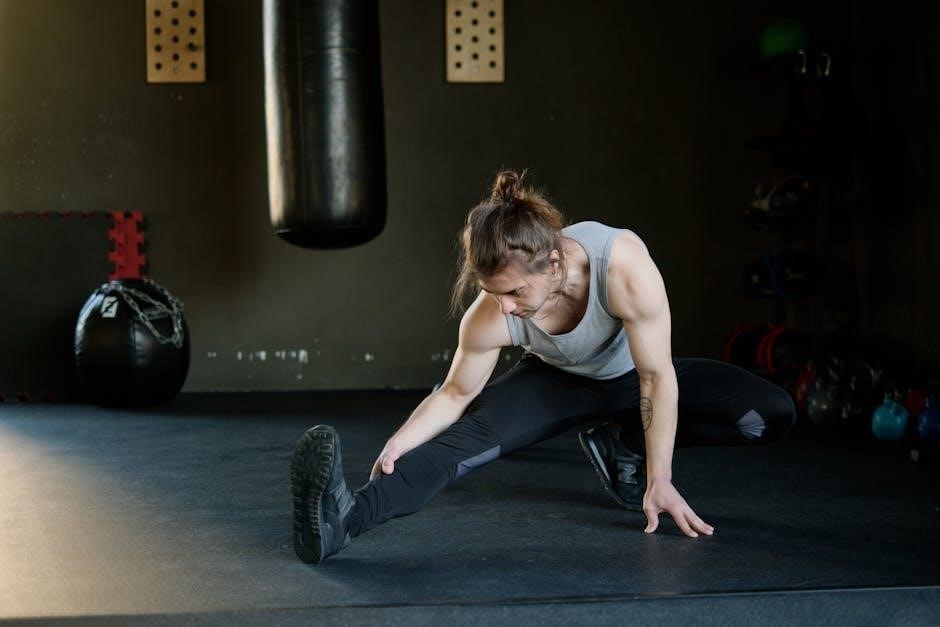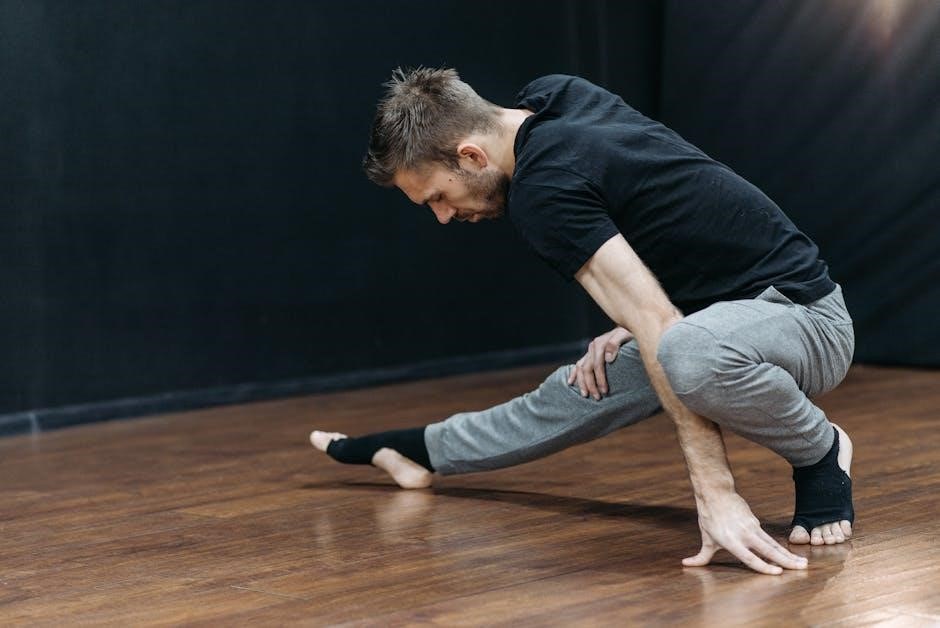Mobility workout routines are gaining popularity as essential for modern lifestyles. Discover how structured programs, like downloadable PDF guides, can enhance flexibility and overall well-being through simple exercises.
Understanding the Importance of Mobility
Mobility is essential for maintaining healthy joints, improving movement quality, and preventing injuries. It enhances flexibility, strength, and overall physical performance, making it vital for everyone, not just athletes. Regular mobility exercises can address sedentary lifestyles, reduce stiffness, and promote better posture. Incorporating mobility routines into daily life supports long-term joint health and reduces the risk of chronic pain. Structured programs, like the FAME Program, offer comprehensive approaches to improve mobility, fitness, and fall-risk reduction. Daily practice, even for a few minutes, can significantly enhance movement efficiency and overall well-being. Prioritizing mobility ensures a stronger, more adaptable body, making it a cornerstone of a balanced fitness regimen.
Benefits of Incorporating Mobility Exercises
Incorporating mobility exercises into your routine offers numerous benefits, including improved joint health, enhanced flexibility, and reduced risk of injury. These exercises promote better movement quality, allowing for more efficient and pain-free daily activities. Regular mobility practice can also boost overall physical performance, making it easier to engage in sports and other forms of exercise. By addressing sedentary lifestyles, mobility workouts help combat stiffness and improve posture. Even short routines, such as a 5-minute daily practice, can lead to significant improvements in joint function and muscle flexibility; Programs like the FAME Program further emphasize the importance of mobility in maintaining long-term health and reducing fall risks. Consistency in mobility exercises ensures a stronger, more adaptable body, making it a vital component of any fitness regimen.

Key Components of a Mobility Workout Routine

A well-rounded mobility routine includes lower body exercises for hip and leg flexibility, upper body stretches for shoulder mobility, and full-body movements to enhance overall joint function.

Lower Body Mobility Exercises
Lower body mobility exercises focus on improving movement quality in the hip complex and legs. Key exercises include Knee To Walls, Wall Squats, and Spider Reaches, targeting hip flexors, quads, and calves. These movements enhance joint flexibility and strength, reducing injury risk. A 5-minute daily routine, such as 10 Wall Squats and 10 Spider Reaches, can significantly improve mobility. Consistency is crucial, so aim to practice these exercises daily or every other day. Incorporating these into your routine promotes better posture, reduces stiffness, and enhances overall lower body function, making daily activities easier and reducing pain. Regular practice strengthens the foundation for more active lifestyles and long-term mobility health.

Upper Body Mobility Exercises
Upper body mobility exercises target the shoulder complex and upper extremities to enhance movement quality and reduce stiffness. Key exercises include shoulder rotations, arm circles, and thoracic spine mobilizations. These movements improve flexibility in the shoulders, chest, and upper back, promoting better posture and reducing injury risk. A daily routine of 10 arm circles and 10 shoulder rotations can significantly boost mobility. Consistency is key, with recommendations to practice 3-5 times per week. Incorporating these exercises into your routine enhances overall upper body function, making daily activities easier and reducing discomfort. Regular practice strengthens the upper body, improving range of motion and long-term mobility health. These exercises are low impact and require no equipment, making them accessible for all fitness levels.
Full Body Mobility Routine
A full body mobility routine combines exercises for the lower and upper body, enhancing overall movement and flexibility. It includes dynamic stretches like leg swings and torso twists, targeting major joints and muscle groups. The routine often starts with gentle movements to warm up the body, followed by more active stretches to improve joint mobility. Key exercises include spider reaches, wall squats, and hip thrusters, which promote balanced movement and reduce stiffness. Daily practice is recommended, with options to break the routine into shorter sessions if preferred. This comprehensive approach ensures all areas of the body benefit, improving posture, reducing injury risk, and enhancing overall physical performance. Consistency is crucial, with goals to complete the routine at least once daily for optimal results and long-term mobility health.

Creating a Personalized Mobility Workout Plan
Start by assessing your current mobility levels using simple exercises from the PDF guide. Set realistic goals and track progress weekly to ensure consistency and improvement in flexibility and joint health.

Assessing Your Current Mobility Levels
Evaluating your mobility is the first step in creating an effective workout plan. Use the exercises outlined in the PDF guide to identify limitations in your range of motion and flexibility. Start with simple movements like knee-to-wall stretches and spider reaches to assess hip and shoulder mobility. These exercises help pinpoint areas needing improvement. For example, if you struggle with deep squats or reaching overhead, note these as focal points. Tracking your progress weekly allows you to monitor improvements and adjust your routine accordingly. Regular assessment ensures your workout remains tailored to your needs, promoting better joint health and overall movement efficiency. Consistency in evaluation is key to long-term success in your mobility journey;
Setting Realistic Goals and Tracking Progress
Setting achievable goals is crucial for maintaining motivation and measuring success in your mobility journey. Start by defining clear, time-bound objectives, such as improving your squat depth or increasing shoulder flexibility within a month. Use the PDF guide’s exercises to track your progress weekly. For instance, note how many spider reaches or wall squats you can perform without discomfort. Celebrate small victories, like increased range of motion, to stay motivated. Adjust your goals as you progress, ensuring they remain challenging yet attainable. Regular tracking helps refine your routine and keeps you committed to long-term mobility improvement. Consistency and patience are key to achieving lasting results and enhancing overall movement quality.

Advanced Mobility Techniques
Advanced mobility techniques incorporate dynamic mobilizations and active stretches, often with equipment, to enhance flexibility, strength, and overall movement quality for optimal performance and injury prevention.
Dynamic Mobilizations and Active Stretches
Dynamic mobilizations and active stretches are powerful techniques to enhance joint mobility and muscle flexibility. These exercises involve controlled movements that increase blood flow and warm up the muscles, preparing the body for more intense activities. Active stretches, which require engagement of specific muscle groups, help improve range of motion and reduce stiffness. Incorporating these into a mobility workout routine can be done with or without equipment, making them versatile for various fitness levels. Regular practice of these techniques not only boosts physical performance but also lowers the risk of injuries, promoting overall well-being and movement efficiency. Consistency is key to achieving long-term benefits.

Incorporating Equipment for Enhanced Mobility
Incorporating equipment into your mobility routine can enhance flexibility and strength. Tools like resistance bands, foam rollers, and balance boards add variety and intensity to workouts. Resistance bands provide gentle tension to deepen stretches, while foam rollers help release muscle tension. Balance tools improve stability and coordination. These devices are often included in mobility workout PDF guides, offering structured routines for all fitness levels. Equipment-based exercises can target specific areas, such as the shoulders or hips, ensuring a well-rounded approach to mobility. Whether at home or in the gym, incorporating equipment makes routines more dynamic and effective, catering to diverse needs and goals.
Consistency is key to improving mobility. Downloadable PDF guides offer structured routines, making it easy to practice daily and enhance overall well-being through targeted exercises.

Final Tips for Consistency and Improvement
Consistency is crucial for seeing progress in mobility. Aim to perform your routine daily or at least 3-5 times per week. Start slow and gradually increase intensity. Use a downloaded PDF guide to track your exercises and stay motivated. Incorporate a mix of dynamic stretches and mobilizations to keep your joints healthy. For those with limited mobility, chair exercises are an excellent option. Remember, even five minutes a day can make a significant difference. Focus on proper form to avoid injury and enhance effectiveness. Over time, these practices will improve your movement quality and reduce injury risk, leading to a more efficient and pain-free lifestyle.
